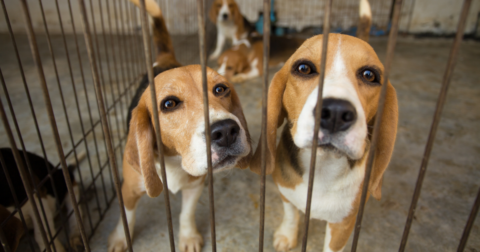Analysis
The Loss of Chevron Could Also Be a Major Loss for Animals
Law & Policy•6 min read
Reported
Charges against three animal rights activists for their open rescue of three dogs have been dismissed.


Words by Jessica Scott-Reid
Update: At a hearing this morning, Judge Mario White granted the State of Wisconsin’s motion to dismiss charges against the three defendants. The trial had been scheduled for March 18, and all three faced felony charges and a possible prison term.
When you think of a factory farm, the animals that come to mind are probably pigs, cows and chickens. But in the U.S. and elsewhere, a number of these massive operations also breed dogs — packing them into small cages to be sold for profit and eventually killed. These animals aren’t farmed for food. Dogs, mostly beagles, are bred for use in animal testing, both here in the U.S. and abroad. Now, three animal advocates who entered one of these facilities back in 2017 and rescued three dogs, are about to stand trial for felony burglary and theft charges, and face possible prison time, up to nine years each.
Eva Hamer says it’s hard for her to make plans for the future right now. On March 18, she and fellow Direct Action Everywhere (DxE) activists, Wayne Hsiung and Paul Darwin Picklesimer, will stand trial for rescuing three dogs, seven years ago, from Ridglan Farms, located near Madison, Wisconsin. According to DxE, the investigators “entered the facility and documented the filthy conditions and the psychological trauma of the dogs spinning endlessly inside small cages.” They then took three dogs, now named Julie, Anna and Lucy, with them.
Ridglan Farms is one of the three largest facilities in the U.S. breeding beagles for research labs. DxE told The Intercept in 2018 that some of those labs are located at public universities in the U.S., including the University of Wisconsin, the University of Minnesota and some colleges associated with the University of California. Nearly 45,000 dogs were used in research in the U.S. in 2021, according to USDA data analyzed by Cruelty Free International. Beagles are the most common breed used in testing due to their docile nature. They are used in toxicity testing, to assess the safety and toxicity of new drugs, chemicals, or consumer products, as well as cosmetic and pharmaceutical testing, and in biomedical research. Tests can be invasive, painful and stressful, and typically end with the dog being euthanized.
At Ridglan, Hamer recalls, beagles were found confined not unlike chickens in the egg industry. “The size to body ratio is similar to a chicken farm,” she says, describing the size of the cages. “If [the cages] are twice the length of a dog’s body, then the dog never needs to leave that cage.” Another similarity to factory farms, she adds, “is the smell, you can smell them from a mile away.” Yet, there was one thing quite different, even “bizarre,” Hamer adds: “Factory farms tend to be quiet at night. At the dog farm, everyone is howling, thousands of dogs, howling.” She describes the sound as haunting.
Hamer, a former music therapist, says she was compelled to participate in this particular investigation and open rescue because it was a “novel project” that could help people “make the connection.” She explains, “Once you meet someone and get to know them, you feel empathy for them. And we’ve all had that experience with dogs,” she says. “Dogs can speak for everyone in that way. They can show the suffering [of all animals farmed and confined].”
Hamer was aware that sacrificing herself and potentially her freedom would help increase public attention on factory farms. While inspiring compassion for animals in cages can be challenging, “if there are humans that might have to go in cages — now it’s newsworthy.” Even knowing she could potentially go to prison, hiding her identity was never an option. Such is one of the principles of open rescue: showing your face signals to the public that there is nothing to hide. “We believe that what we are doing is legal and we are doing something for a much greater good; preventing a much greater harm,” she adds.
“We are normal people,” fellow open rescuer Jenny McQueen told Sentient last year, and open rescue helps normalize “that it’s okay to go in and to take animals from these awful places.”
While “there is a lot of shock that facilities like this exist,” says Hamer, there is also a sort of legitimacy behind their existence, ‘in the name of science,’ so to speak. But as she asserts, “this is not about being anti-science. To say that we need to transition away from animal-based research is what the scientific evidence says.” It is a common false dichotomy, “this idea that ‘If I could save a thousand humans and kill one dog, of course I would kill one dog,’ – this is just a complete misunderstanding of the science.” In fact, over ninety percent of new drugs shown to be safe and effective in animal tests, go on to fail in human trials. In many ways, reliance on animal models in testing and research is actually holding science back, and holding back the discovery of real human cures.
For now, Hamer admits she is nervous. “Any chance of prison is scary.” But she is also looking forward to exposing America’s dog farms to the broader public, and to sharing the message about open rescue. “I’m really excited about having this conversation in court,” she says, “and getting to convince a jury that animals are worth saving, that it isn’t criminal to save them.”